

“Our Lenten Journey:
The Garden of Gethsemane”
Matthew 26:36-39
Pastor Kevin Vogts
Trinity Lutheran Church
Paola, Kansas
Lent Service II—March 9, 2022
Grace to you and peace from God our Father and the Lord Jesus
Christ. Amen.
The theme for our Wednesday evening sermons during Lent this year is “Our
Lenten Journey,” focusing on the locations of Christ’s final sufferings and
death. We began last week with “The Upper Room,” where Christ
celebrated the Passover with his disciples and instituted the Sacrament of Holy
Communion. This week we continue with “The Garden of
Gethsemane.”
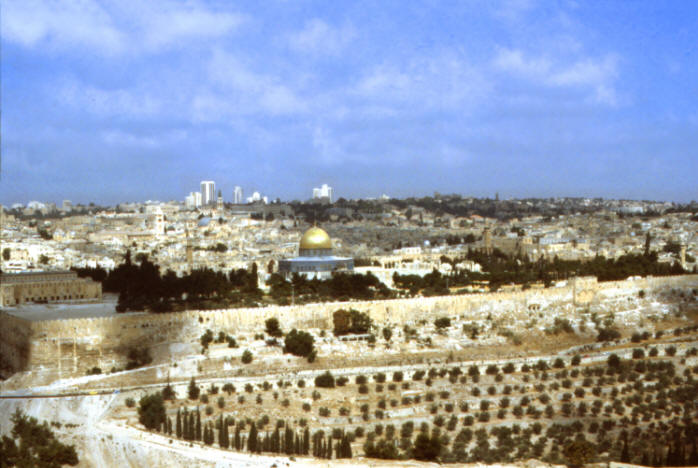
This picture shows the walled city of Jerusalem, looking west from the Mount
of Olives, across the Kidron Valley.
Like many ancient cities, Jerusalem is built upon a mount and surrounded by
valleys and foothills. Jesus and his disciples ate the
Passover within the walled city. Jewish tradition dictated
that the Passover meal began when the first three stars were visible in the sky,
about 6:00pm.
It was probably about 9:00 o’clock on Maundy Thursday evening when Jesus and
the disciples exited through one of the city gates and crossed the Kidron Valley
on the east side of the city.
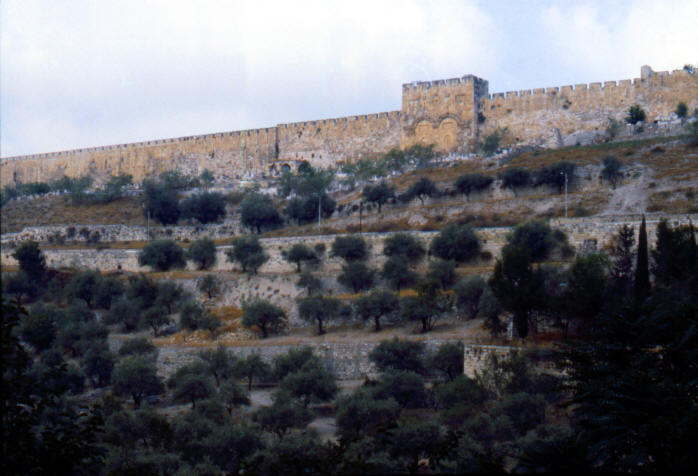
This picture is looking up at the city walls from the bottom of the Kidron
Valley. The word “kidron” in Hebrew means “dark, gloomy.”
The valley running along the east side of Jerusalem was probably called
the “Kidron Valley” because it was a deep ravine with trees along the brook at
the bottom, so compared to bright desert sun it was dark and gloomy down there.
But, of course the name Kidron Valley also has a deep symbolic, even
prophetic significance. For, on Maundy Thursday when Jesus cross through the
Kidron Valley, he was literally walking through the dark, gloomy “valley of the
shadow of death.”
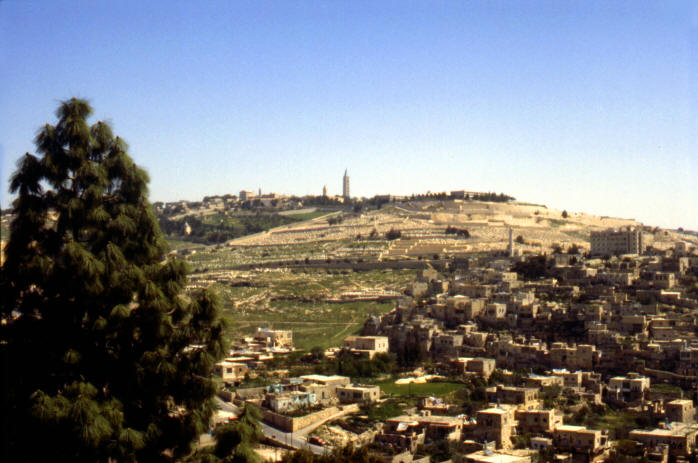
This picture is looking at the Mount of Olives from Jerusalem, across the
Kidron Valley. It was called the Mount of Olives because in
ancient times olive groves covered its terraced slopes.
Matthew and John report, “Jesus left with his disciples and crossed the
Kidron Valley . . . to the Mount of Olives . . .
to a place called Gethsemane. And he said to them,
‘Sit here while I go over there and pray.’ He took Peter and the two sons of
Zebedee along with him, and he began to be sorrowful and troubled. Then he said
to them, ‘My soul is overwhelmed with sorrow to the point of death. Stay here
and keep watch with me.’ Going a little farther, he fell with his face to the
ground and prayed, ‘My Father, if it be possible, let this cup pass from me.
Yet not as I will, but as you will.’”
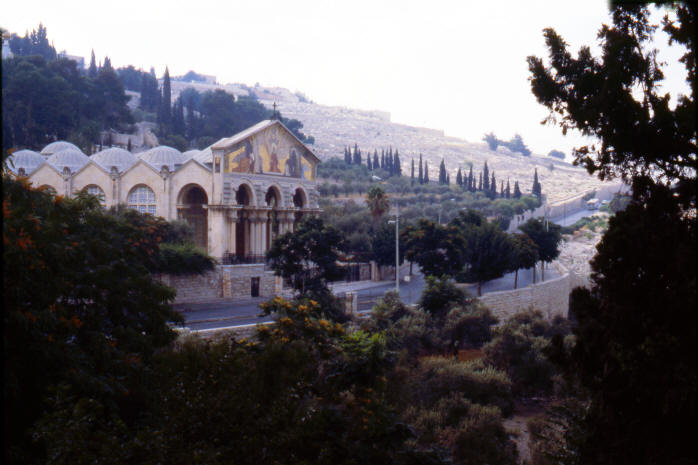
Today, at the base of the Mount of Olives the Church of All Nations is
located on the site of the Garden of Gethsemane.
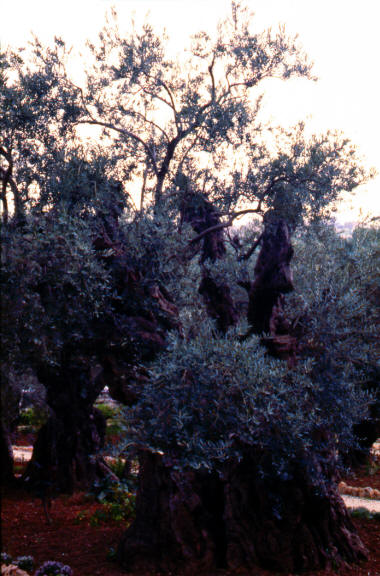
Next to this church is a small grove of ancient olive trees.
Olive trees regenerate from the roots, and studies have shown that the
trees today in the Garden of Gethsemane still grow out of ancient roots of the
very trees that witnessed Christ praying here that night nearly 2,000 years ago.
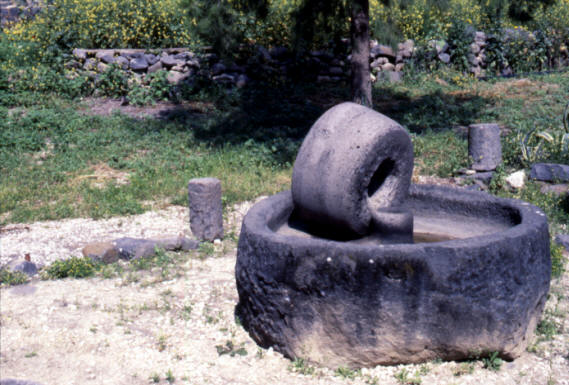
The word “gethsemane” means “oil press,” so it seems the Garden of Gethsemane
included a press to squeeze the oil from the olives, like this one from
Capernaum which was powered by a donkey.
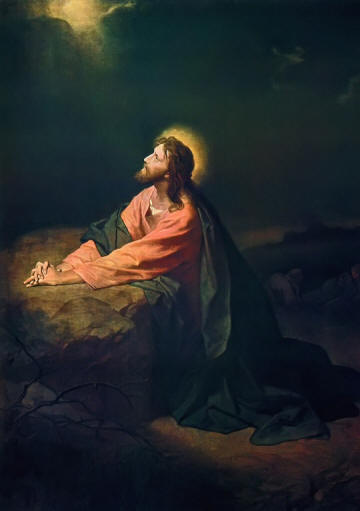
This is the most famous, familiar portrait of Christ Praying in the Garden of
Gethsemane, painted by German artist Heinrich Hofmann in 1890.
We learn two lessons from Christ’s agony in the Garden of Gethsemane.
Point #1) We learn from Christ’s agony in the Garden of Gethsemane how he
suffered for our salvation.
What did Jesus mean when he said, “My Father, if it be possible, let this cup
pass from me”? Imagine drinking from a cup of deadly acid
which you know will sear your throat and kill you. The “cup”
Jesus speaks of was far more terrifying than that. The “cup”
Jesus speaks of was symbolic of the torture he was about to endure.
Both the physical torture, flogged, beaten, crucified; and especially the
spiritual torture, the sinless Son of God taking upon himself the sins of the
world, suffering on the cross the damnation we deserve. As
Peter says, “He himself bore our sins in his body on the cross.”
When Jesus prays, “My Father, if it be possible, let this cup pass from me,”
he is saying, “If it is possible to redeem the world without me drinking this
horrible cup of death and wrath and damnation, then relieve me of this cup.”
But, there was no other way to save us from our sins except for God’s own
Son to give himself up as an atoning sacrifice.
Jesus willingly gave himself up for you. As he says in the
Gospel of John, “I am the Good Shepherd . . . and I lay down my life for the
sheep. . . No one takes it from me, but I lay it down of my
own accord.” John says, “The blood of Jesus, his Son,
cleanses us from every sin.” That is what Jesus did for you,
by his suffering, by his death on the cross, by his resurrection.
On account of his sacrifice you are forgiven, you are cleansed in God’s
sight of every sin. We learn from Christ’s agony in the
Garden of Gethsemane how he suffered for our salvation.
Point #2) We learn from Christ’s agony in the Garden of Gethsemane how to
cope with pressure and sorrow.
Have you ever seen one of those stress inventories, where you give certain
points for different things happening in your life, and your level of stress is
indicated by total? In my conversations with you I find so
many whose stress goes off the scale. Just everyday life can
be overwhelming: the demands, the pressures, the struggles.
Add to that sickness, pain, depression, money troubles, work and school
struggles, family problems, divorce, the death of a loved one.
For two years we all endured the strain and anxiety an unprecedented
pandemic, and now we face economic uncertainty and even warfare, and the list
goes on and on. “My soul is overwhelmed with sorrow to the
point of death.” We learn from Christ’s agony in the Garden
of Gethsemane how to cope with pressure and sorrow.
“Jesus went with his disciples to a place called Gethsemane, and he said to
them, ‘Sit here while I go over there and pray.’” Medical
science has actually demonstrated that prayer reduces stress and anxiety.
And a much greater authority, the Psalms, say: “Call upon me in the day
of trouble; I will deliver you, and you will honor me”; “Cast your burden upon
the Lord, and he will sustain you.” We learn from Christ’s
agony in the Garden of Gethsemane to cope with pressure and sorrow—first of all,
with prayer.
“He fell with his face to the ground and prayed, ‘My Father, if it be
possible, let this cup pass from me. Yet not as I will, but as you will.’”
That’s the other thing we learn from Christ’s agony in the Garden of
Gethsemane about coping with pressure and sorrow: We learn to trust in our
heavenly Father’s loving care and put it all into his hands.
Many times in the Bible we are directed to bring our wants and desires to the
Lord in prayer: “Do not be anxious about anything, but in everything, by prayer
and petition, with thanksgiving, present your requests to God”; “Pray in the
Spirit on all occasions with all kinds of prayers and requests”; “Ask and you
shall receive; seek and you will find; knock and the door shall be opened to
you.”
But, many times also in the Bible we are directed to trustfully accept God’s
will, to pray as Jesus did, “Yet not my will but yours be done”: “Trust in the
Lord with all your heart and lean not on your own understanding; in all your
ways acknowledge him, and he will make your paths straight”; “And we know that
God works all things together for the good of those who love him”; “Thy will be
done on earth as it is in heaven.”
Martin Luther puts it this way: “How does Christ himself pray in the Garden
of Gethsemane? This is a practical and indispensable example
which we ought to follow gladly and not forget. Our Lord
Jesus Christ adds these words to his prayer: ‘Yet not my will but yours be
done.’ You should do likewise. If you are
in tribulation and suffering, turn to God as a child turns to his father, cry to
him for help and say: ‘O heavenly Father, see what things are happening to me!
For the sake of your dear Son Jesus Christ help me!’
But since God alone knows what is good and useful for us, we should place his
will first and our will second.”
That is the key to peace of mind: Trusting in your heavenly Father’s loving
care and putting it all into his hands. As Paul says in
Romans, “If God is for us, who can be against us? . . . Who
shall separate us from the love of Christ? Shall trouble or hardship or
persecution or famine or nakedness or danger or sword? . . .
No, in all these things we are more than conquerors through him who loved us.
For I am convinced that neither death nor life, neither angels nor
demons, neither the present nor the future, nor any powers, neither height nor
depth, nor anything else in all creation, will be able to separate us from the
love of God that is in Christ Jesus our Lord.”
In your life you will face your own “Gethsemanes,” when you are overwhelmed
and sorrowful. We learn from Christ’s agony in the Garden of
Gethsemane how much he suffered for us, and how to cope with pressures and
sorrows in our lives: Taking it to the Lord in prayer and
putting it all into his hands, trusting in his loving care.
Return to Top | Return to Sermons | Home | Email Church Office